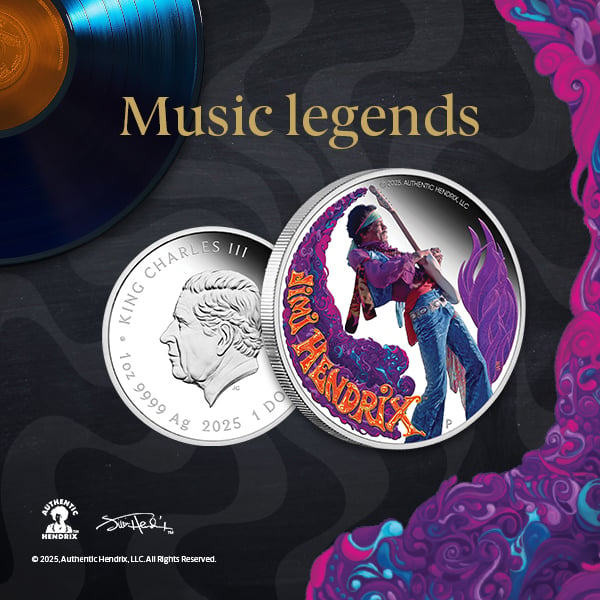Six royal effigies of Her Majesty Queen Elizabeth II on Australian coinage

Since it was claimed that Charles II wished to "turn his back" on Oliver Cromwell, convention has dictated that each monarch faces in the alternative direction to his or her predecessor.
While the switch from the left-facing King George VI (as you look at his coins) to the right-facing Elizabeth II was expected, Mary Gillick’s 1952 effigy of The Queen clearly took a new approach.
Nottingham-born Gillick beat off competition from 16 other artists with her graceful design depicting the head and shoulders of the young, uncrowned monarch wearing a simple laurel wreath.
The Melbourne Mint considered the effigy “very beautiful, but rather difficult to do.” Meanwhile, the Commonwealth Treasury complained:
“Seeing that the effigy of the late King George VI is quite clear cut, we do not understand why the effigy of Queen Elizabeth II should not be equally clear.”
In its response from London, The Royal Mint underlined the fact that Gillick’s treatment represented a “deliberate departure” from tradition.
Despite the controversy it stirred at the time, the delightful image of the young Queen remains a favourite for many. It featured on Australian coins until decimalisation in 1966 when the Arnold Machin portrait was introduced (thereby pre-dating its adoption by British coins by two years).
Stoke-born Machin is justly famous for another portrait of The Queen, which featured on British stamps from 1967. It has been described as the most reproduced portrait of all time - literally, there have been billions.
Earlier, in 1964, he had been chosen to design a new effigy for The Royal Mint - remarkably, his first numismatic project.
For his ‘decimal’ portrait, Machin was granted four sittings at Buckingham Palace and Balmoral. The work depicts a young but regal Queen, wearing her favourite diadem, the ‘Girls of Great Britain and Ireland’ diamond tiara, given to her as a wedding present by her grandmother, Queen Mary, in 1947.
When The Royal Mint unveiled the new coinage, numismatist and author H.W.A. Linecar wrote that it “adhered to the last vestige of tradition”.
The third portrait was created by Jerusalem-born Raphael Maklouf. Like Machin, he was an accomplished sculptor when he tackled his first coin design.
The new likeness showed The Queen with the 1820 Royal Diamond Diadem, which she first wore to the State Opening of Parliament in November 1952, and on the journey to her Coronation on June 1953.
It has been said that the Maklouf’s image, which appeared on coins in 1985, depicts Her Majesty somewhat younger than her then 58 years. But it was his avowed intention to produce a ‘regal and ageless’ symbol.
In 1996, the Royal Mint invited entries for an updated effigy. Of the 19 entries submitted, three designs were reviewed by The Queen herself, including one from Vladimir Gottwald, a member of the Royal Australian Mint's Design and Engraving Section.
However, it was Ian Rank-Broadley’s “strong and realistic” effigy of The Queen that appeared on Australian coins in 1998.
The British designer noted, that as well as being Head of State, she was also a real person. “There is no need to flatter her,” he told the Times newspaper. “She’s a 70-year old woman with poise and bearing. One doesn’t need to see a rather distant mask.”
However, there was reward for Czech-born Gottwald in 2000, when he became the first Australian designer since Sir Edgar Bertram Mackennal to see his work on the obverse of an Australian coin after it was approved for a one-time striking on the Australian 2000 Royal Visit 50 cent piece.
Gottwald personally presented a coin with the new portrait to Her Majesty in March 2000 during her official visit to Australia. He got to meet her a second time in 2006 and was honoured to see his work also appear on a select number of numismatic coins.
A sixth effigy of The Queen since her accession to the throne in 1952 began appearing on Australian coins in 2019. It was created by British designer Jody Clark, the youngest of the six portraitists and the first to use computer graphics to complete his work.
In time-honoured fashion it depicts The Queen facing right. She is wearing the Royal Diamond Diadem featured by Maklouf and (in the Australian adaptation) the Coronation necklace. Despite Clark’s age and methods, the likeness is seen as a nod to the past, in tune with the return to traditional design following some remarkable and bold experiments over the past 70 years.
Now we await with great anticipation the unveiling of the first effigy of King Charles III – facing left of course!
Permission/reference
Image of the Vladimir Gottwald effigy of Her Majesty Queen Elizabeth II reproduced with permission of the Royal Australian Mint.













